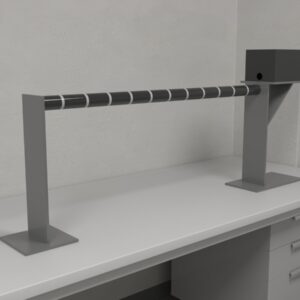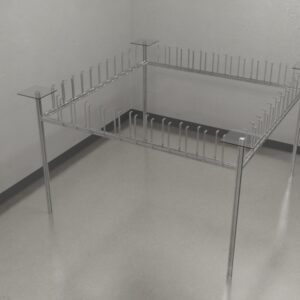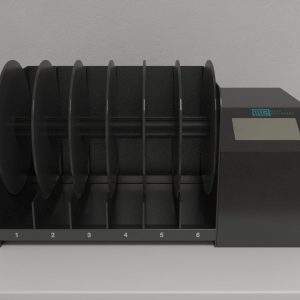$1,990.00
The incline rolling ladder test is a newly developed method designed to assess tactile and proprioceptive sensitivity. This test, introduced by Fagoe et al., is used to evaluate functional impairments in rats.
The incline rolling ladder consists of a ladder leading to a platform, positioned at a 45-degree angle. The rungs of the ladder feature a stationary textured section and a movable smooth section that can roll. Subjects are allowed to climb the ladder to reach the platform, and data is gathered on the number of successful steps taken, the slips that occur, and the specific sections where these slips happen.

MazeEngineers empowers preclinical neuroscience research with meticulously designed, customizable behavioral apparatuses. From manual classic mazes to fully automated smart systems, we provide the tools scientists need to capture high-quality, reproducible data for studies on learning, memory, anxiety, and depression.

bool(false)


Mouse / Rat Features |
34 cm long ladder |
Platform for landing at the top of the ladder. |
The ladder is set at an angle of 45 degrees. |
9 adjustable rungs. |
Each rung has a half smooth and mobile surface; and half textured and immobile surface. |

The incline rolling ladder test is a newly developed method that is particularly sensitive to tactile and proprioceptive stimuli. Fagoe et al. introduced this test to investigate functional deficits in rats with dorsal column (DC) lesions. The dorsal column, located in the posterior spinal cord, is responsible for transmitting sensory information such as touch, vibration, and proprioception to the brainstem. Therefore, tests designed to detect functional changes due to DC lesions need to be highly responsive to these types of stimuli.
In experimental studies, spinal cord lesions often result in mild functional impairments that are typically short-lived and challenging to detect over time. An effective functional test should be capable of identifying these transient deficits as well as any improvements following experimental treatments. The incline rolling ladder test draws inspiration from texture discrimination tests used by Vierck et al. in monkeys, which demonstrated that long-term texture discrimination deficits could be observed after injury. Subsequent research by Ballermann et al., involving tactile discrimination in rats, further supported the use of rat models for assessing sensorimotor deficits following spinal cord injuries.
The incline rolling ladder is composed of a ladder leading to a platform, positioned at a 45-degree angle. The rungs of the ladder consist of a fixed textured section and a movable smooth rolling section. Subjects are allowed to climb the ladder to reach the platform, and data is recorded on the number of successful steps, the slips that occur, and the specific sections where these slips happen.
The incline rolling ladder features a 34 cm long ladder that connects to a landing platform at the top. The ladder is inclined at a 45-degree angle and includes 9 adjustable rungs. Each rung is divided into two sections: one side is smooth and movable, while the other side is textured and stationary.
The subjects are kept in standard housing conditions with continuous access to food and water, and a 12-hour light/dark cycle. Prior to beginning the training, it is essential to thoroughly clean the apparatus to eliminate any residual stimuli that could influence the subjects’ performance. The tests should be conducted in a well-lit, sound-isolated environment. Tracking and recording of the trials can be carried out using a system like the Noldus EthoVision XT.
Subjects undergo daily training for two weeks before baseline measurements are taken. After establishing the baseline, subjects receive treatment or undergo a procedure, depending on the experimental design. The test is then repeated weekly for 8-12 weeks to monitor changes and any potential recovery.
To perform the incline rolling ladder test, set the apparatus on a flat surface. Place a subject at the base of the ladder and allow it to climb to the platform. Each subject is tested in three trials per day, with the orientation of the ladder rungs—smooth/movable and textured/immobile—randomly altered for each trial.
Evaluation of Sensitivity to Functional Deficits Following Cervical or Thoracic Dorsal Column Transection
Fagoe et al. used rats with cervical or thoracic dorsal column lesions to evaluate the sensitivity of various tests in detecting functional deficits and recovery. They employed tests targeting proprioceptive sensory deficits, such as the horizontal ladder, CatWalk gait analysis, and rope crossing test, as well as tests for tactile sensation, like the adhesive tape removal test. The researchers also developed the incline rolling ladder test to assess deficits in both proprioception and tactile discrimination.
Spinal cord lesions typically result in significant early functional deficits, but these effects diminish quickly, making it challenging for most tests to detect subtle deficits over time. The incline rolling ladder test, however, was shown to be consistently sensitive in detecting deficits up to 6-7 weeks post-injury. The study suggests that the incline rolling ladder test could be a valuable tool in research focused on monitoring functional recovery following spinal cord lesions and evaluating treatment effectiveness.
Data from the test is recorded based on the number of successful steps, the number of slips, and the type of rung (smooth or textured) where these events occur. The data is categorized into two key measurements:
Good Smooth Steps Measure – This metric counts the number of successful steps taken on smooth rungs, compared to slips on smooth rungs or steps taken on textured rungs.
Slip Measure – This metric compares the number of slips to the successful steps made on smooth rungs.
The incline rolling ladder test is a relatively recent development, primarily tested in rats to date. Additional research is needed across various animal models to further establish its sensitivity. The apparatus could be enhanced by incorporating additional rungs or by implementing a protocol that includes more trial runs to improve the test’s sensitivity.
Fagoe ND, Attwell CL, Eggers R, Tuinenbreijer L, Kouwenhoven D, Verhaagen J, Mason MR (2016). Evaluation of Five Tests for Sensitivity to Functional Deficits following Cervical or Thoracic Dorsal Column Transection in the Rat. PLoS One. 11(3):e0150141. DOI: 10.1371/journal.pone.0150141
Vierck CJ Jr, Cooper BY (1998). Cutaneous texture discrimination following transection of the dorsal spinal column in monkeys. Somatosensory & Motor Research 15(4), 309-315. DOI: 10.1080/08990229870718
Ballermann M, Tompkins G, Whishaw IQ (2000). Skilled forelimb reaching for pasta guided by tactile input in the rat as measured by accuracy, spatial adjustments, and force. Behavioural Brain Research 109(1), 49–57. DOI: 10.1016/S0166-4328(99)00164-3
| Species | Mouse, Rat |
|---|
There are no questions yet. Be the first to ask a question about this product.